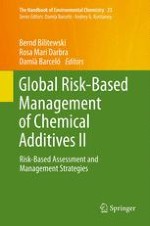2013 | OriginalPaper | Buchkapitel
Life Cycle Assessment of Additives: Methodology and Data
verfasst von : Ester van der Voet, Lauran van Oers, Tomas Rydberg, Jenny Westerdahl, Henrik Fred Larsen
Erschienen in: Global Risk-Based Management of Chemical Additives II
Verlag: Springer Berlin Heidelberg
Aktivieren Sie unsere intelligente Suche, um passende Fachinhalte oder Patente zu finden.
Wählen Sie Textabschnitte aus um mit Künstlicher Intelligenz passenden Patente zu finden. powered by
Markieren Sie Textabschnitte, um KI-gestützt weitere passende Inhalte zu finden. powered by
